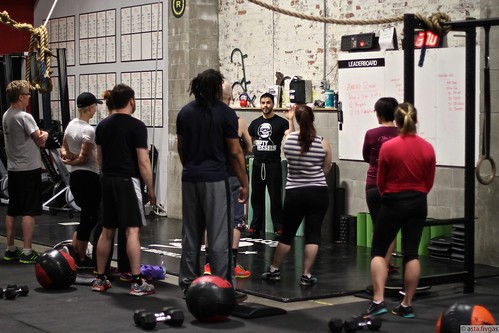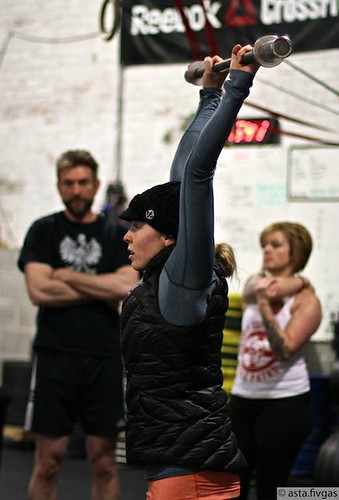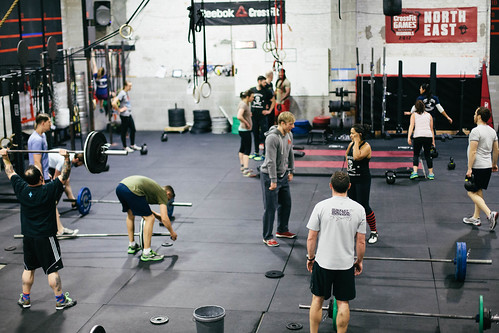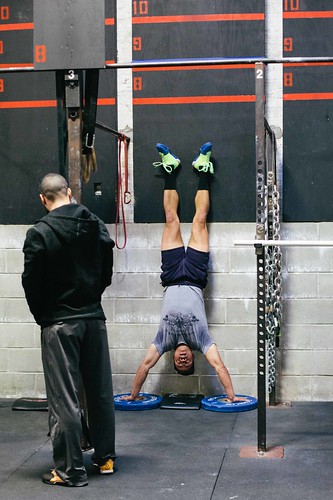
As CrossFit continues to grow in popularity, affiliate owners and coaches will naturally wind up with far more potential business. When I started my affiliate in 2007, the number of people contacting me about joining the gym every month could be managed on a few post-it notes. CFSBK now has a front desk staff and full-time administrator who manages our membership and deals with the high volume of training requests we get. CrossFit's popularity makes running a profitable affiliate more possible, and whether you're a new affiliate in a big city or an established gym located in the sticks, you're going to have to deal with managing larger group classes. Our next two articles will address just that.
I'd like to note that large is a relative term. I remember back when I was running workouts in the park, a five to eight-person class seemed gigantic to me. Being outside limited my programming options and since I had only been doing one-on-one sessions over the previous year at a large gym, I was rusty working in a group setting. So for the purposes of this article, we’ll define large as a situation that potentially strains your available resources (equipment, staff, square footage, and your own experience) and requires maximal efficiency. At CFSBK in our 4,500 square-foot facility, we average about 20 people per class with a typical larger class creeping up to around 30. Below, I've listed some practices and principles that help us run these classes in the most effective, efficient, and professional manner possible. I hope you can apply some of this to your own coaching situation, whatever it may be.
 Eliminate Ambiguity
Eliminate Ambiguity
This is undoubtedly the most important component of managing a large group class well. Clarity is important regardless of class size, but its utility exponentially grows as class attendance grows. You'll know you're blowing it if running class feels similar to herding cats and you're hearing the same kinds of questions over and over again. It's your professional responsibility to make sure no one is confused about what's expected of them, regarding the details of the workout, how long they have to complete different class segments, and what kind of space they have. Getting everyone on the same page ensures that every component of class runs smoothly and everyone works together instead of being on top of each other.
In two previous articles, I wrote about the effective use of time stamps and organizing lifting segments within classes. If you haven't read them or are a bit hazy on the details, I recommend going back and reviewing these class management strategies, as they are highly effective for running large classes. Here are four additional tips to help eliminate ambiguity:
 1. At the end of white board segments, make sure to ask if anyone has any questions.
1. At the end of white board segments, make sure to ask if anyone has any questions.
If one person asks something, chances are five other people were curious about the same thing. Pay attention to the kinds of questions you’re getting. If you hear the same ones often, it probably means you’re missing something, not your athletes. Adjust the content of your white board review or initial instruction to preempt these questions.
2. Remember that some people are better visual learners while others are better at internalizing auditory cues.
Make sure that you're both demonstrating and talking about movements so that everyone has an equal chance of getting on the same page about the particular exercise. Demonstrating a couple reps of a movement can go a long way for curbing confusion and questions, no matter how excellent your verbal cues.
3. New people will be the most confused about what to do or how they should approach their training each day.
After CFSBK’s white board briefing, if someone is brand spanking new, we'll proactively approach them and make sure they know what to do and if they don't, we provide them an easy-to-follow plan. For example, if we're in our fifth week of pressing and someone just graduated from Foundations, we might go over to them and tell them to simply work up to a medium-heavy set of five. Then if there’s still time, they can work three sets at that weight. This is also a good way to break the ice with new members so they know you're available to them, and it normalizes the fact that they’ll initially need some extra help.
4. Be flexible and prepared to modify the plan and communicate it to the class if something isn't working or needs to change.
Maybe your workout originally included rowing but given the class size, a running component is more viable. Perhaps you were going to have one giant heat, but after all the equipment was brought out, you realized it wouldn't be practical and instead are going to have to run two heats. These kinds of adjustments shouldn't be happening often but part of the process of getting better as an affiliate involves making mistakes and correcting them along the way.
 Leverage Your Coaches
Leverage Your Coaches
As your membership gets bigger, you will most likely need to increase your staffing per class. Out of CFSBK’s 60 weekly group classes, 10 of them only have one coach on-duty. Having at least two coaches makes running a class much easier. Not only can you split up the work, but while one coach leads movement prep or reviews at the white board, the other coach can figure out things such as how they'll need to pair up people, whether the workout will require heats based on available space, and how the class size will affect time stamps. By the time one coach gets to the next segment, the other coach will already have a specific plan about how it will run and can take the lead. Additionally, one coach can work with particularly troubled movers while the other coach leads warm-up sequences such Olympic lifting reviews. Here are three tips for managing work and leveraging your coaching eye:
1. Have a plan for distributing work.
At the beginning of CFSBK’s classes, our coaches already know who will lead each segment—from movement prep to warm-ups to white board review, to the lifting segments and WODs—so that the workload is even. Having a plan ahead of time both demonstrates preparedness and gives each coach a clear understanding of his or her duties. While flow notes are often written into our internal programming calendar, our evening coaches also often touch base with morning coaches to get some pointers on how earlier classes ran and if any adjustments need to be made to the plan.
 2. Make each coach responsible for part of the class during lifting segments.
2. Make each coach responsible for part of the class during lifting segments.
After partnering athletes off to bars or the relevant equipment, split the class evenly between the two coaches so that instead of two coaches walking around eight active squat racks catching what they can, each coach is assigned four racks, providing more consistent exposure to the same lifters.
3. Consider programming some on-the-minute work.
On the minute or any pre-set interval work can easily provide very potent workouts and doubles the usage of your equipment and space within a workout. This may mean less total people working at the same time, which makes the coach’s job easier since you can methodically move between stations and provide feedback more easily. You can apply this interval format to Olympic lifting, developing gymnastics strength, as well as getting some serious conditioning. Here are examples of each.
Every minute, on the minute for 15 minutes, perform:
Power Clean 80-85% x 2
One barbell per team, partner A goes at the top of each minute and partner B goes on the :30 mark. Since people will be paired up by barbell based on their target weights, people can either use the same weight or make a quick change after each work interval. By having each partner consistently switch the plates on one side of the barbell, load adjustments are quick and easy.
Every :30 alternate the following work for a total of 12 minutes:
1-3 Handstand Push-Ups or 3-8 Traditional Push-Ups
1-5 Strict Pull-Ups Partners start at opposite stations and rotate every 30 seconds. Provide rep ranges so people can self regulate the amount of volume they need to achieve the stimulus that will develop strength and muscular stamina.
Partners start at opposite stations and rotate every 30 seconds. Provide rep ranges so people can self regulate the amount of volume they need to achieve the stimulus that will develop strength and muscular stamina.
Alternate the following work each minute for a total of 18 minutes:
10 Heavy Kettlebell Swings
10 Burpees
Partners start at opposite stations and rotate every minute. When you structure work like this, it's best to cap it at a certain time to preserve the intended stimulus. For example you might say that regardless of where you're at by the :20, :30, or :45 mark, stop working. This preserves the rest interval component of these kinds of workouts. Let your people know that if you're only getting say, six and five reps in by the cut-off mark, you should modify your volume goals to those or slightly more per round.
I hope this article has given you a few new ideas about how you can run large numbers of people through group classes. Next week in Part 2, we’ll address how creating different levels of programming can increase the efficiency of a group class, and we’ll also share some practical tips for managing various types of lifts and WODs.